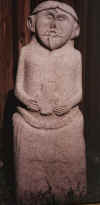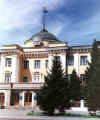These images are all stored as compressed JPEG's. Be patient; although the files are
small it may take a while these to transfer and decompress. It's worth it, though!
You can click on either the thumbnail or the hyperlink to get a bigger
version of the image.


 This is a stone man that is now kept in the yard of the national
museum in Kyzyl. This man traditionally would have stood out in a field and is presumed to
have marked the grave of a clan leader or the head of a rich family, but it is so old
(about 4,000 years old) that no one really knows for sure what purpose the statues served.
This statue us very similar to one we
saw out near Ak-Dovorak , in the western half of the country. The statue is
shorter than a person, as you can see in this picture that gives it some perspective; this
is the same stone man, with
our guide, a translator, and one of my fellow travellers. This is a stone man that is now kept in the yard of the national
museum in Kyzyl. This man traditionally would have stood out in a field and is presumed to
have marked the grave of a clan leader or the head of a rich family, but it is so old
(about 4,000 years old) that no one really knows for sure what purpose the statues served.
This statue us very similar to one we
saw out near Ak-Dovorak , in the western half of the country. The statue is
shorter than a person, as you can see in this picture that gives it some perspective; this
is the same stone man, with
our guide, a translator, and one of my fellow travellers.
 Here's a picture of the Tuva Ensemble sitting around on
their horses at the side of a lake. The Ensemble is a singing group that has toured in
North America, and a few of those in this photo have since formed another popular group,
Huun-Huur-Tu. Here's a picture of the Tuva Ensemble sitting around on
their horses at the side of a lake. The Ensemble is a singing group that has toured in
North America, and a few of those in this photo have since formed another popular group,
Huun-Huur-Tu.
 Here's a picture taken inside a yurt that we visited. In the
foreground is the chimney of the wood stove in the lower right corner, as well as some
pots and bowls full of the dairy products we have just been fed. In the background is an
elaborately carved wooden chest, as well as a decorative cloth draped over the TV set. Here's a picture taken inside a yurt that we visited. In the
foreground is the chimney of the wood stove in the lower right corner, as well as some
pots and bowls full of the dairy products we have just been fed. In the background is an
elaborately carved wooden chest, as well as a decorative cloth draped over the TV set.
 When we were in the city of
Ak-Dovorak, we got to see the local
wrestling championships . Tuvan wrestling is a little different; two men, wearing
traditional boots, tight briefs, and a long-sleeved open-chested vest square off. The
first to touch the ground with anything other than his feet loses, and that seems to be
the only rule. As the wrestlers are introduced to the crowd before the match, they do the
dance of the eagles, where they wave their hands like an eagle wings; the winner will also
get to do the dance of the eagle around the flag pole after the match. The referees are
also visible in this photo in their bright robes. When we were in the city of
Ak-Dovorak, we got to see the local
wrestling championships . Tuvan wrestling is a little different; two men, wearing
traditional boots, tight briefs, and a long-sleeved open-chested vest square off. The
first to touch the ground with anything other than his feet loses, and that seems to be
the only rule. As the wrestlers are introduced to the crowd before the match, they do the
dance of the eagles, where they wave their hands like an eagle wings; the winner will also
get to do the dance of the eagle around the flag pole after the match. The referees are
also visible in this photo in their bright robes.
 We spent a few nights in a yurt at the side of the Ak-Sug .
Ak-Sug translates as white water, and you can see a little bit of the rushing river on the
upper right side of the photo; it is so white it looks like it might be a road. This
picture was taken from a ridge overlooking the narrow Ak-Sug valley, and the taiga
(forest) on the other side of the river quickly rises up the side of a mountain. We spent a few nights in a yurt at the side of the Ak-Sug .
Ak-Sug translates as white water, and you can see a little bit of the rushing river on the
upper right side of the photo; it is so white it looks like it might be a road. This
picture was taken from a ridge overlooking the narrow Ak-Sug valley, and the taiga
(forest) on the other side of the river quickly rises up the side of a mountain.

 These two photos were taken by singer Kongar-ool Ondar. The strange man in the picture should
be well known to most people. I'm not quite certain what Boris Yeltsin is doing in these photos, but he visited
Tuva in June of 1994 and these pictures were taken in Bai-Taiga district just south-west
of Kyzyl. On the right hand side of the second photo you can see K.A. Bicheldei, the
chairman of the Tuvan Supreme Parliament.
These two photos were taken by singer Kongar-ool Ondar. The strange man in the picture should
be well known to most people. I'm not quite certain what Boris Yeltsin is doing in these photos, but he visited
Tuva in June of 1994 and these pictures were taken in Bai-Taiga district just south-west
of Kyzyl. On the right hand side of the second photo you can see K.A. Bicheldei, the
chairman of the Tuvan Supreme Parliament.

 Speaking of
singer Kongar-ool Ondar ,
here's a picture of him and his family taken downtown in Kyzyl, in the fall. In the
background is Tuva's national theatre, and far in the background (off to the left) you can
see the Parliament Building . Speaking of
singer Kongar-ool Ondar ,
here's a picture of him and his family taken downtown in Kyzyl, in the fall. In the
background is Tuva's national theatre, and far in the background (off to the left) you can
see the Parliament Building .
Return to The Friends of Tuva Page.
| 

